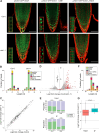Arabidopsis AGO1 N-terminal extension acts as an essential hub for PRMT5 interaction and post-translational modifications
- PMID: 38769059
- PMCID: PMC11317149
- DOI: 10.1093/nar/gkae387
Arabidopsis AGO1 N-terminal extension acts as an essential hub for PRMT5 interaction and post-translational modifications
Abstract
Plant ARGONAUTE (AGO) proteins play pivotal roles regulating gene expression through small RNA (sRNA) -guided mechanisms. Among the 10 AGO proteins in Arabidopsis thaliana, AGO1 stands out as the main effector of post-transcriptional gene silencing. Intriguingly, a specific region of AGO1, its N-terminal extension (NTE), has garnered attention in recent studies due to its involvement in diverse regulatory functions, including subcellular localization, sRNA loading and interactions with regulatory factors. In the field of post-translational modifications (PTMs), little is known about arginine methylation in Arabidopsis AGOs. In this study, we show that NTE of AGO1 (NTEAGO1) undergoes symmetric arginine dimethylation at specific residues. Moreover, NTEAGO1 interacts with the methyltransferase PRMT5, which catalyzes its methylation. Notably, we observed that the lack of symmetric dimethylarginine has no discernible impact on AGO1's subcellular localization or miRNA loading capabilities. However, the absence of PRMT5 significantly alters the loading of a subgroup of sRNAs into AGO1 and reshapes the NTEAGO1 interactome. Importantly, our research shows that symmetric arginine dimethylation of NTEs is a common process among Arabidopsis AGOs, with AGO1, AGO2, AGO3 and AGO5 undergoing this PTM. Overall, this work deepens our understanding of PTMs in the intricate landscape of RNA-associated gene regulation.
© The Author(s) 2024. Published by Oxford University Press on behalf of Nucleic Acids Research.
Figures







References
-
- Bologna N.G., Voinnet O.. The diversity, biogenesis, and activities of endogenous silencing small RNAs in Arabidopsis. Annu. Rev. Plant Biol. 2014; 65:473–503. - PubMed
-
- Zhan J., Meyers B.C.. Plant small RNAs: their biogenesis, regulatory roles, and functions. Annu. Rev. Plant Biol. 2023; 74:21–51. - PubMed
-
- Zhang H., Xia R., Meyers B.C., Walbot V.. Evolution, functions, and mysteries of plant ARGONAUTE proteins. Curr. Opin. Plant Biol. 2015; 27:84–90. - PubMed
MeSH terms
Substances
Grants and funding
- ESF Investing
- European Union
- EUROPEAN RESEARCH EXECUTIVE AGENCY
- SEV-2015-0533/Severo Ochoa Programme'
- 2019 BP 00159/Beatriu de Pinós
- Government of Catalonia
- Horizon 2020
- Nº 801370/Marie Sklodowska-Curie
- RYC2020-029185-/H2020-MSCA-IF-2019
- ID100010434/MCIN/AEI /10.13039/501100011033
- MICIU/AEI/10.13039/ 501100011033
- EUR2020-112097/ERDF A way of making Europe
- 2021 SGR 01066/European Union NextGenerationEU/PRTR
- Direcció General de Recerca (DGR) del Departament de Recerca i Universitats (REU)
- Generalitat de Catalunya
- CERCA Programme
- Ministerio De Ciencia e Innovación
- SEV-2015-0533/Severo Ochoa Programme for Centres of Excellence in R&D
LinkOut - more resources
Full Text Sources
Research Materials
Miscellaneous

